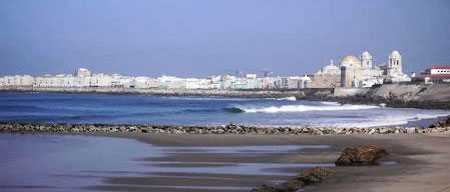Home > Study in Spain > City Guide > Cádiz
Cádiz City Guide
- Places of Interest
- Maps
- Getting to
- Getting around the city
Situated on the southwestern coast of Spain, in the region of Andalusia, is the wonderfully unique port of Cadiz. Famed all over the world for its February carnival celebrations, the city is abuzz with festivity and gaiety all year round. The beaches in Cadiz are said to be some of the most beautiful in Spain, especially the Playa de la Caleta, situated between the castles of San Sebastian and Santa Catalina, and the pleasant climate makes it an enjoyable place to be at any time of the year.
Cadiz is the most ancient city still standing in Western Europe, with its founding rumoured to date back to 1104 BC. Like many Andalusian cities, its architecture represents the many changing influences the city has been under throughout history, from the Phoenicians, to the Romans, to the Visigoths, to the Moors. The city is also important in Spain's history as the place from which Columbus sailed on his voyage to the Americas.
This city has so much to offer, that there is bound to be something for everyone. Whether you are relaxing on the beach, taking in the breath-taking architecture or enjoying the fun of the Carnival, Cadiz will be a city that you will never want to leave.
Places of Interest
Castillo de San Sebastian
Although you can't go inside this military fortification itself, you can take a walk along the 750m causeway leading out from Playa Caleta to its gate.
Castillo de Santa Catalina
Situated on the other side of Playa Caleta is another military fortification, Castillo de Santa Catalina, built in 1596 after the English sacking of the city. It has been recently renovated and plays host to a variety of exhibitions, including one on Cádiz and the sea.
Cathedral
This cathedral sits on the site of the old cathedral, which burnt down in 1596. Reconstruction began in 1776, under the supervision of the architect Vicente Acero, who also built Granada cathedral. However, Acero decided to leave the project and hand it on to other architects, the result being a building period of 116 years, and a variety of changes made to Acero's original Baroque design. The most evident of these are the neoclassical elements of the dome, towers and main façade. Climb inside the Torre de Poniente (accessed from a separate entrance on Plaza de Catedral) for fabulous views.
Plaza de San Juan de Dios
Dominated by the imposing Ayuntamiento building, this plaza is filled with cafés to watch the gaditanos (the people of Cádiz) going about their daily life.
Teatro Romano
In 1980, in the El Pópulo district of the city, some warehouse buildings were destroyed in a fire. In the aftermath, an amazing discovery was made. It turned out that in this destruction of the warehouse, the remains of a Roman theatre had been discovered! It is the second largest Roman theatre in the world, after Pompeii.
Museums
Museo Catedralicio
With your cathedral ticket, you can go into the Museo Catedralicio, where you can see an excavated medieval street, as well as items related to the sacking of 1596 and a variety of artwork.
Museo de Cádiz
The major museum of the city, situated in a large, leafy Plaza. Attractions include two Phoenician marble sarcophagi and a statue of the Roman Emperor Trajan.
Beaches
Playa de la Caleta
Said to be one of the nicest beaches in Spain. Gets very busy during the summer.
Playa de la Victoria
Beautiful wide beach with Atlantic sand stretching about 4km along the peninsula.
Carnival
The carnival in Cádiz is one of the most famous in the world, and although it technically only takes place over a few weeks in February, the carnival is evident in the city throughout the year, with rehearsals, public demonstrations and contests taking place. Gaditanos are said to be the funniest people in Spain, and so much of the carnival is based on satirical humour. The most famous manifestation of this is the chirigotas, who perform comedic musical pieces.
Maps
Getting to Cádiz
By air
The nearest international airport is in Jerez de la Frontera (35km away). The next one is Seville (130km away).
By bus
The bus company Comes runs buses from various cities in Andalucia. Secorbus operates up to six services a day to Madrid for 22€.
Getting around the city
The best way to see the city is on foot, as you can find hidden treasures in nooks and crannies. However, the city also has an extensive and cheap bus system, and coach tours and taxis are also widely available.
Tips
Cádiz is a relatively safe city, but as with all cities, it is important to watch out for pickpockets and petty theft, particularly during carnival time.

